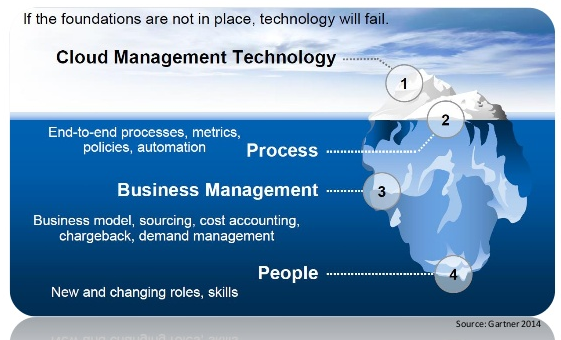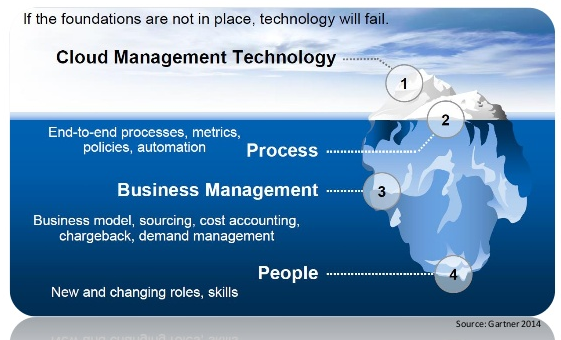
Last week I attended the AE Foyer of Matthias Pyck, "From server virtualization to hybrid cloud". Matthias Pyck is one of the pioneers in the Belgium Cloud scene. This blog takes you through the story of Matthias. Showing you a way to the Cloud.
A few weeks ago Gartner gave an insight of what we can expect in Infrastructure & Operations (I&O):
"By 2017, 50% of I&O teams will be eliminated or have major budget reductions because they are viewed as outdated, high-cost, legacy support organizations."
The conclusion / warning for the I&O teams was:
"Improve or Perish"
The operational debt
Because the I&O standards aren't optimized we see an FTE cost that is about 60% of the TCO. Setting up infrastructure is primarily manual with no automated workflows resulting in higher personnel costs. Without capacity planning, you've probably already found yourself in a situation with unnecessary hardware, software or service procurements.
Neglecting to document the infrastructure (because of the lack of resources) results in increased meantime to diagnose. Not adopting infrastructure and operational standards results in a higher cost of technical support as well as potentially lower service quality.
So, do we make the best use of our hardware, licenses and facilities?
Ask yourself
- Do you think about your resources (servers, storage, networking) in a pooled fashion rather than as individual entities?
- Can you provide elasticity in services and applications, so that they can expand with an increased demand and contract when it goes away?
- Can you track usage so that you can show back or charge back to users, or user departments, the compute power they are using?
- Have your end users have self provisioning capabilities?
If the answer to all 4 questions is "Yes", then you are ready to go to the cloud. If not: there is work to be done.
How to get in the Cloud?
"Through 2017, at least 70% of enterprises will have the potential to reduce their I&O costs by 25% or more - while retaining service quality." (Gartner)
The market has changed, not the hardware cost alone but also the sum of knowledge & energies cost will put cloud services in a more interesting cost position without compromising. Just keep in mind:
A 3 step approach
1. Server virtualization to Industrialized Operations
Analyse the 'as-is' of today and define were you want to go.
Define and create a situation of infrastructural consistency across all environments & applications providing a fast provisioning that is (automated or self) serviced.
Create a clear road map / implementation plan and prepare a business case (Capex - Opex and ROI).
Industrialize your virtualization environment by simplifying and standardizing and automating the provisioning and de-provisioning of servers, monitoring included.
Through solid automation you have industrialized your operations and reduced the FTE cost, optimized your license cost and most likely optimized the number of servers. But do not forget to involve development since they will be impacted and why not: will benefit from the new situation. We are ready for an elastic environment. However: keep in mind that "elastic applications" is not an I&O goal/requirement only, it requires your applications to be designed to be elastic. Architecture is a must.
2. Industrialized Operations to Private Cloud
Investigate and select a Cloud Model that implements your strategic direction in terms of application and technologies. Redefine your application architecture to get your software stack in line with the market. (Think IaaS, PaaS, SaaS,...) Based on your cloud model you should align and adapt the backup, monitor and DRP.
Reducing the operation debt with freedom of location, cloud provider and partnerships. Once your software stack is in line with the market & required SLA's, your FTE will go down.
3. Private Cloud to Hybrid Cloud.
In a hybrid cloud model you can make fast changes & enforce consistency of devices, systems and applications on premise or in the cloud. You can implement platform release and align application life-cycle management.
With automated bendable infrastructure you can assure your base demand in the private cloud and use the public cloud for 'getting the work done' at peak moments with SLA based service models in place.
Re-evaluate previous choices by price and pay for the time a server is required.
Conclusion
Increase you IT efficiency and improve productivity by simplification, standardization and automation. Keep it simple and straightforward. Simplicity is prerequisite for reliability. Choose for innovation & standardization.
Think of a flexible manageable IT environment by using the private and public cloud and focus on cost awareness.
Getting started
Use a hammer to pound nails and a screw driver to turn screws. There are many factors that determine which cloud service model to use.
How can we help you?
- Free quick assessment
- Full assessment - ROI
- Implementation plan
- Recommendations and strategy
- ...
Let's start the conversation.








